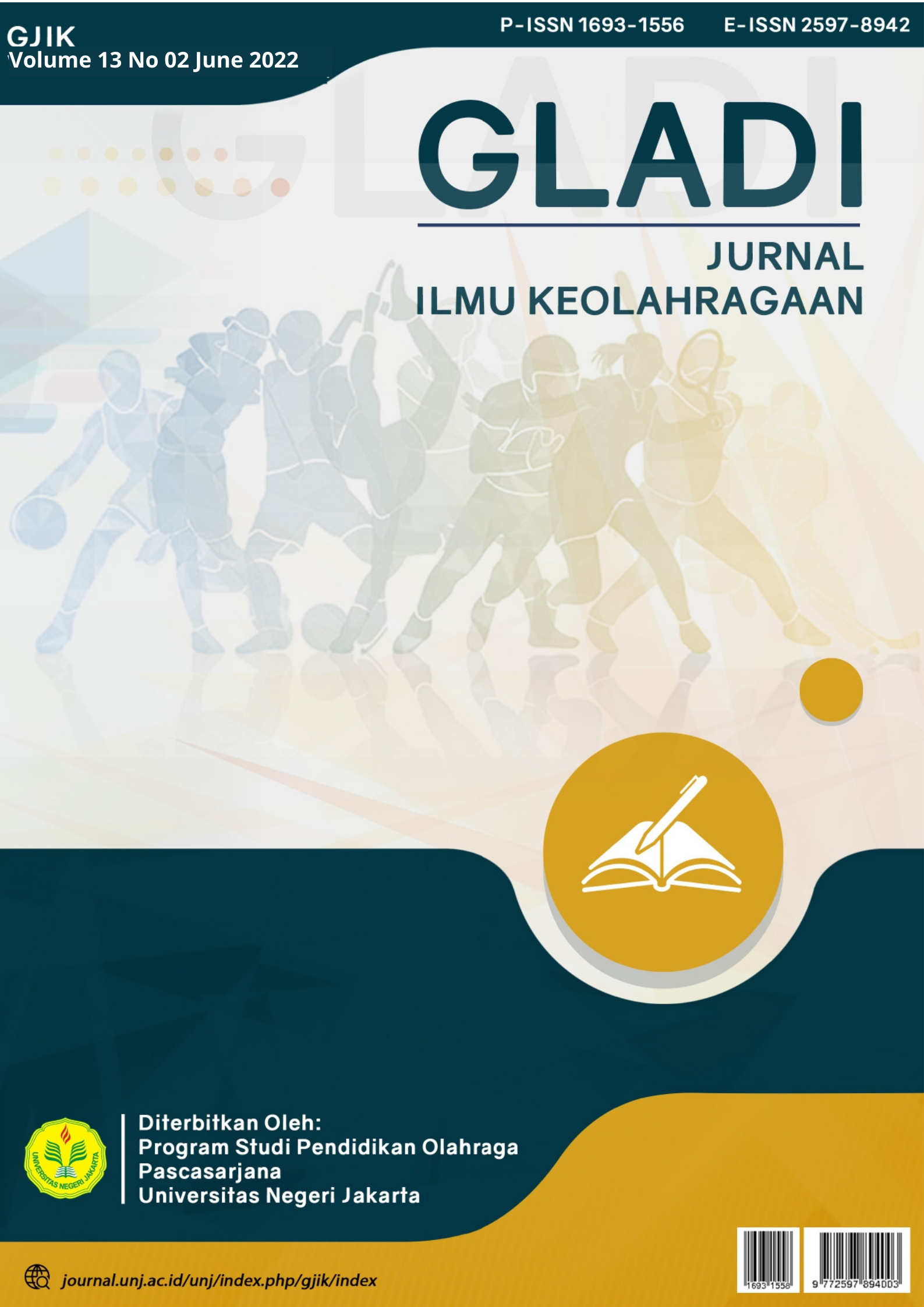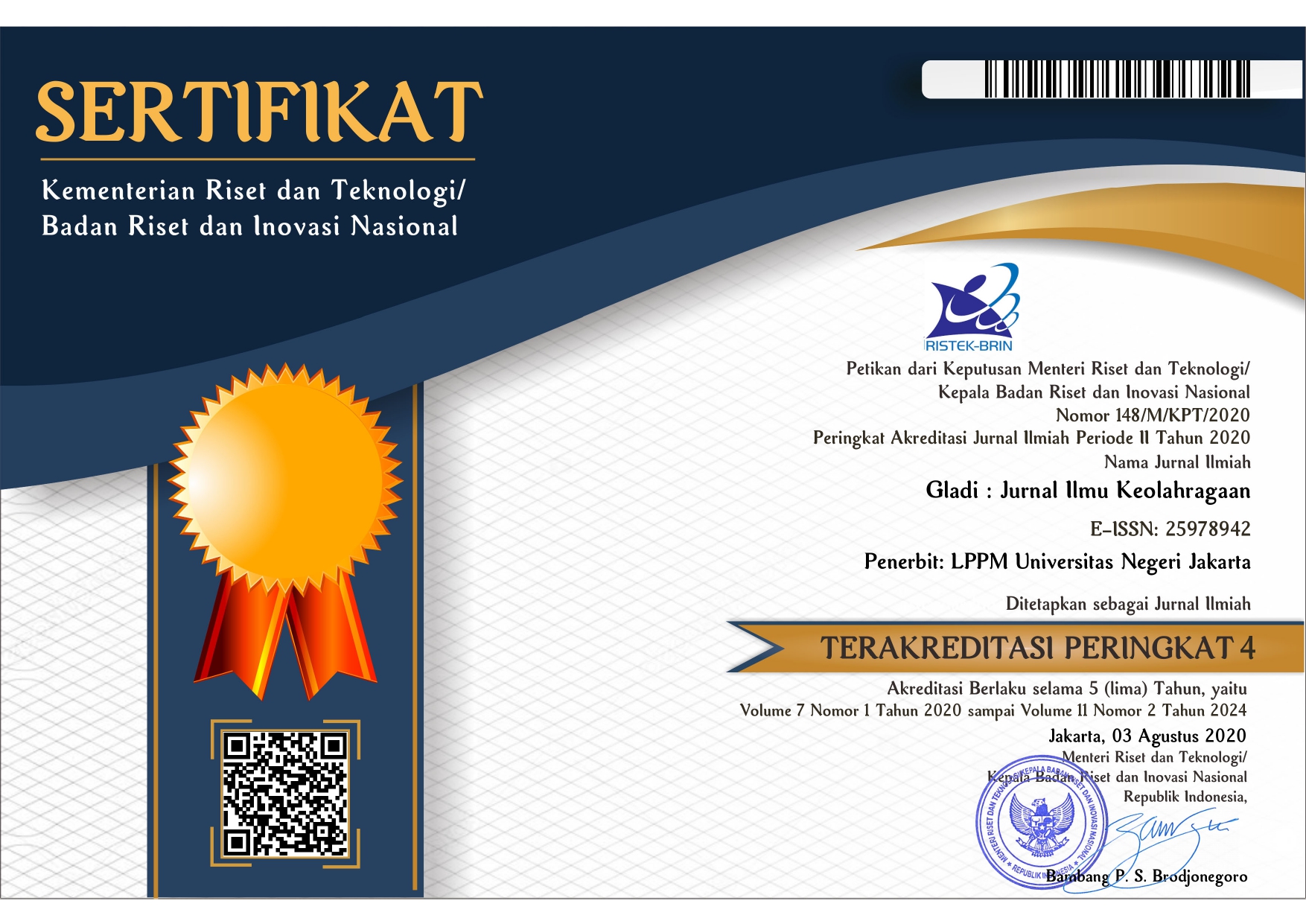The effect of exercise therapy and range of motion (rom) on chronic ankle instability (cai) in pelatda pon xx athletes dki jakarta province
Keywords:
therapy online; offline; rom; chronic ankle instabilityAbstract
The purpose of this study is to determine the effect of exercise therapy methods and athlete's ROM on chronic ankle instability (CAI). The research method is an experiment with a treatment by level 2x2 design. The population of the athletes of Pelatda PON XX DKI Jakarta Province who experience chronic ankle sprain is 74 athletes. The number of samples from each level are: group (B1) is 27% of 74 = 19.98 (20) sample and group (B2) is 27% of 74 = 19.98 (20) sample. The research sample was 40 people. Hypothesis testing using the Tukey test. Based on the research results, it can be concluded: 1) there is a significant difference between the A1 and A2 methods on Y. Judging from Fo = 54.269 sig. 0.00<0.05. 2) There is a significant interaction effect between A and B on Y. Judging from Fo = 54.269 sig. 0.00<0.05. 3) there is a significant difference in Y using exercise therapy A1 and A2 in group B1. This is evidenced by the value of sig. 0.00<0.05. 4) there is a significant difference in Y results using exercise therapy A1 and A2 in group B2. It is proven by the value of sig. 0.00<0.05.
Downloads
References
Doherty, C., Bleakley, C., Delahunt, E., & Holden, S. (2017). Treatment and prevention of acute and recurrent ankle sprain: An overview of systematic reviews with meta-analysis. British Journal of Sports Medicine, 51(2), 113–125. https://doi.org/10.1136/bjsports-2016-096178
Donovan, L., & Hertel, J. (2013). A new paradigm for rehabilitation of patients with chronic ankle instability. Physician and Sportsmedicine, 40(4), 41–51. https://doi.org/10.3810/psm.2012.11.1987
Fadilla, M. R. (2018). Pengaruh Terapi Latihan “Geregkutara” Terhadap Penurunan Nyeri Dan Peningkatan Fungsi Pasca Cedera Ankle Pada Pemain Futsal GPS. Universitas Negeri Yogyakarta.
Gruskay, J. A., Brusalis, C. M., & Heath, M. R. (2019). Pediatric and adolescent ankle instability : diagnosis and treatment options. https://doi.org/10.1097/MOP.0000000000000720
Hamid, J. (2018). CEDERA OLAHRAGA (Dalam Perspektif Ilmu Kedokteran Olahraga). Jakarta: Sarnu Untung.
Hamzah, A., Fauziah, E., & Sa’diah, M. (2020). Kombinasi Plyometric Training Dengan Mobilization With Movement Lebih Baik Dibanding Kombinasi Plyometric Training Dengan Strain Counter Strain Dalam Meningkatkan Keseimbangan Dan Range Of Motion Ankle Joint Pada Kasus Chronic Ankle Instability Di Klinik . FISIO MU: Physiotherapy Evidences, 1(2), 59–67. https://doi.org/10.23917/fisiomu.v1i2.10702
Herzog, M. M., Kerr, Z. Y., Marshall, S. W., & Wikstrom, E. A. (2019). Epidemiology of ankle sprains and chronic ankle instability. Journal of Athletic Training, 54(6), 603–610. https://doi.org/10.4085/1062-6050-447-17
Kushartanti, B. W. (2015). Terapi Latihan Pascacedera Bahu. Medikora, V(2), 212–226. https://doi.org/10.21831/medikora.v0i2.4685
Lin, C. W. C., Hiller, C. E., & De Bie, R. A. (2010). Evidence-based treatment for ankle injuries: A clinical perspective. Journal of Manual and Manipulative Therapy, 18(1), 22–28. https://doi.org/10.1179/106698110X12595770849524
Loudon, J. K., Reiman, M. P., & Sylvain, J. (2014). The efficacy of manual joint mobilisation/manipulation in treatment of lateral ankle sprains: A systematic review. British Journal of Sports Medicine, 48(5), 365–370. https://doi.org/10.1136/bjsports-2013-092763
M.P.T, D. G. H. B. (2017). The Effectiveness of Mobilization and Thera band Exercises for Ankle Sprain. Journal of Medical Science And Clinical Research, 05(06), 23213–23218. https://doi.org/10.18535/jmscr/v5i6.69
Maffulli, N., Longo, U. G., Gougoulias, N., Caine, D., & Denaro, V. (2011). Sport injuries: A review of outcomes. British Medical Bulletin, 97(1), 47–80. https://doi.org/10.1093/bmb/ldq026
Petersen, W., Rembitzki, I. V., Koppenburg, A. G., Ellermann, A., Liebau, C., Brüggemann, G. P., & Best, R. (2013). Treatment of acute ankle ligament injuries: A systematic review. Archives of Orthopaedic and Trauma Surgery, 133(8), 1129–1141. https://doi.org/10.1007/s00402-013-1742-5
Riyanto, S., & Wahyuni. (2019). Pengaruh tandem walking exercise dan ankle strategy terhadap keseimbangan dinamis pada lansia di posyandu abadi I Gonilan. University Research Colloqium, 05, 413–418.
Roi, G. S. (2010). Return to competition following athletic injury: Sports rehabilitation as a whole. Apunts Medicina de l’Esport, 45(167), 181–184. https://doi.org/10.1016/j.apunts.2010.01.003
Setiawan, A. (2011). Faktor Timbulnya Cedera Olahraga. Media Ilmu Keolahragaan Indonesia, 1(1). https://doi.org/10.15294/miki.v1i1.1142
Sumartiningsih, S. (2012). Cedera Keseleo pada Pergelangan Kaki (Ankle Sprains). Media Ilmu Keolahragaan Indonesia, 2(1). https://doi.org/10.15294/miki.v2i1.2556
Syafrianto, D., Muchlis, A. F., & Ayu, N. P. (2021). Functional ankle instability didefinisikan sebagai perasaan subjektif dari ketidakstabilan dan cedera berulang pada pergelangan kaki , keseleo pergelangan kaki simtomatik ( atau keduanya ) karena defisit proprioceptive dan neuromuskuler , hal ini mengakib, 6, 19–27.
Wikstrom, E. A., & Brown, C. N. (2014). Minimum reporting standards for copers in chronic ankle instability research. Sports Medicine, 44(2), 251–268. https://doi.org/10.1007/s40279-013-0111-4







